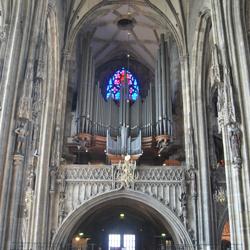
A contract to resuscitate and renovate the great gallery organ of St. Stephen’s Cathedral, Vienna, Austria, was signed in April with Rieger Orgelbaufirma of Vorarlberg, Austria. Beginning in November and continuing over the next three years, the gallery organ, the largest in Austria, will be thoroughly rebuilt.
Unplayable since 1991, the instrument will be re-inaugurated on Easter Day, April 12, 2020, exactly 75 years after the organ’s predecessor, dating to 1886 and built by Walcker, was destroyed by fire near the end of World War II. The present organ of four manuals, 125 registers, and 10,000 pipes was built by Johann M. Kauffmann of Vienna between 1956 and 1960.
The entire organ will be dismantled and taken to Rieger’s workshops. Rieger has two organs installed on the floor of the cathedral nave. The gallery organ and the 1991 Rieger organ of 4 manuals, 55 registers in the south aisle will be made playable from one console.
For information: http://www.rieger-orgelbau.com/.

